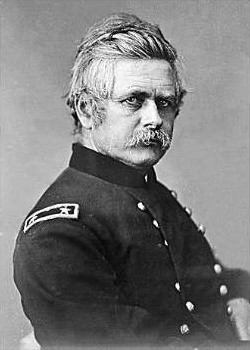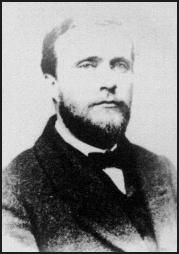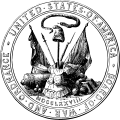
Edward Richard Sprigg Canby was a career United States Army officer and a Union general in the American Civil War. He served as a military governor after the war.

Edward Otho Cresap Ord was an American engineer and United States Army officer who saw action in the Seminole War, the Indian Wars, and the American Civil War. He commanded an army during the final days of the Civil War, and was instrumental in forcing the surrender of Confederate General Robert E. Lee. He also designed Fort Sam Houston. He died in Havana, Cuba of yellow fever.

The Battle of Fort Blakeley took place from April 2 to April 9, 1865, in Baldwin County, Alabama, about 6 miles (9.7 km) north of Spanish Fort, Alabama, as part of the Mobile Campaign of the American Civil War. At the time, Blakeley, Alabama, had been the county seat of Baldwin County.
The Army of the Gulf was a Union Army that served in the general area of the Gulf states controlled by Union forces. It mainly saw action in Louisiana and Alabama.

Wesley Merritt was an American major general who served in the cavalry of the United States Army during the American Civil War, American Indian Wars, and Spanish–American War. Following the latter war, he became the first American Military Governor of the Philippines.
The Battle of Spanish Fort took place from March 27 to April 8, 1865, in Baldwin County, Alabama, as part of the Mobile Campaign of the Western Theater of the American Civil War.
XIII Corps was a corps of the Union Army during the American Civil War. It was first led by Ulysses S. Grant and later by John A. McClernand and Edward O.C. Ord. It served in the Western Theater of civil war, Trans-Mississippi Theater and along the Gulf of Mexico.

The XVI Army Corps was a corps of the Union Army during the American Civil War. The corps rarely fought as a single unit, as its divisions were often scattered across the country.

Andrew Jackson Smith was a United States Army general during the American Civil War, rising to the command of a corps. He was most noted for his victory over Confederate General Stephen D. Lee at the Battle of Tupelo, Mississippi, on July 14, 1864.

John Charles Black was a Democratic U.S. Congressman from Illinois. He received the Medal of Honor for his actions as a Union Army lieutenant colonel and regimental commander at the Battle of Prairie Grove during the American Civil War.

Frederick Steele was a career military officer in the United States Army, serving in the Mexican-American War, the Yuma War, and as a major general in the Union Army during the American Civil War. He was most noted for retaking much of secessionist Arkansas for the Union cause, escaping the besieged port-city of Camden through successful deception tactics, and defeating Sterling Price and E. Kirby Smith at Jenkins Ferry.

The western theater of the American Civil War encompassed major military operations in the states of Alabama, Georgia, Florida, Mississippi, North Carolina, Kentucky, South Carolina and Tennessee, as well as Louisiana east of the Mississippi River. Operations on the coasts of these states, except for Mobile Bay, are considered part of the Lower Seaboard Theater. Most other operations east of the Appalachian Mountains are part of the eastern theater. Operations west of the Mississippi River took place in the trans-Mississippi theater.
Wilson's Raid was a cavalry operation through Alabama and Georgia in March–April 1865, late in the American Civil War. U.S. Brig. Gen. James H. Wilson led his U.S. Cavalry Corps to destroy Confederate manufacturing facilities and was opposed unsuccessfully by a much smaller force under Confederate Lt. Gen. Nathan Bedford Forrest.

The 5th Minnesota Infantry Regiment was a Minnesota USV infantry regiment that served in the Union Army in the Western Theater of the American Civil War and Dakota War of 1862. The regiment distinguished itself serving in its home state and the south, particularly at the Battles of Fort Ridgely, Corinth and Nashville.

Bryan Morel Thomas was an American soldier, farmer, marshal, and educator. He served as an officer in the United States Army, and later in the Confederate States Army during the American Civil War. He was a son-in-law of Jones M. Withers, under whom Thomas would serve in the war. Thomas also participated in and was captured during the 1865 Battle of Fort Blakeley, the conflict's final infantry fight.

George Leonard Andrews was an American professor, civil engineer, and soldier. He was a brigadier general in the Union Army during the American Civil War and was awarded the honorary grade of brevet major general.

Peter Joseph Osterhaus was a German-American Union Army general in the American Civil War and later served as a diplomat.

Miles Daniel McAlester was a career United States Army officer and a Union Army major during the American Civil War. In 1867, he was nominated and confirmed for appointment to the grade of brevet brigadier general in the Regular Army, to rank from April 9, 1865.
The following units and commanders of the Union Army fought at the Mobile campaign of the American Civil War involving the battles of Spanish Fort and Fort Blakeley. The units engaged against Spanish Fort involved Veatch's Division, Benton's Division and Henry Bertram's Brigade from the XIII Corps along with McArthur's Division and Carr's Division from the XVI Corps. The units engaged against Fort Blakeley involved Veatch's Division and Andrews' Division from the XIII Corps, Garrard's Division from the XVI Corps and Steele's Pensacola Column. The Confederate order of battle is shown separately.

Cyrus Ballou Comstock was a career officer in the Regular Army of the United States. After graduating from the United States Military Academy at West Point in 1855, Comstock served with the Army Corps of Engineers. At the beginning of the American Civil War, he assisted with the fortification of Washington, D.C. In 1862, he was transferred to the field, eventually becoming chief engineer of the Army of the Potomac. In 1863 during the Siege of Vicksburg, he served as the chief engineer of the Army of the Tennessee.














